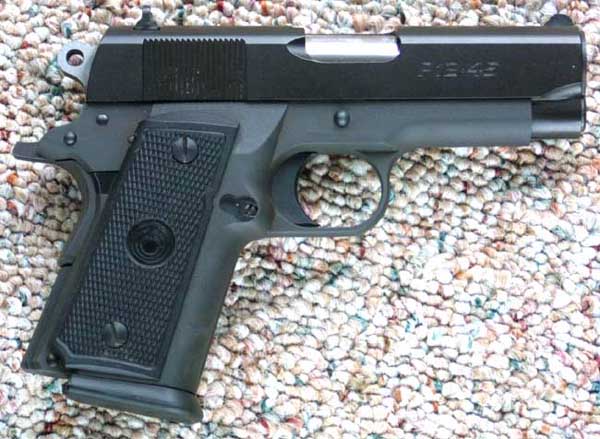 Para-Ordnance P12-45
Para-Ordnance P12-45
| Dimensions | Barrel Length | Weight | Caliber | Action Type | Magazine capacity |
| 7 ½ Inches | 3 ½ Inches | 24 oz. | .45 A.C.P. | S.A. Semi Auto | 12+1 |
For a more complete description of the basic gun, please see the section on the P14-45, upon which this model is based. In comparison to the larger, P14, there is no barrel bushing on this little pistol. Instead, the end of the barrel flares out to engage the muzzle tip of the slide when it comes back into battery. This is similar to the way in which the Colt Officer's model was designed. It also uses, like the Officer's Model, a set of dual recoil springs.
The gun will take the full sized P14 magazines, although they will stick out of the bottom. It also shares the high profile, three dot sights, with it's full sized brethren. Though I never really cared for the three dot sight system, these sights are a definite improvement over the dismal little sights on the Colt guns.
Needless to say, this little gun is a handful to shoot, in all but the literal sense. The light weight, and short barrel make for memorable perceived recoil. I can not seem to shoot better than about 4" groups with this gun at 25 yards. Whether it is the recoil and small size, or the gun itself I can not say.
Disassembly
| Disassembly of the P-12 is a bit of a pain, as
the process differs somewhat from that of the standard M1911. The process
begins by depressing the recoil spring plug, and turning the barrel bushing
very slightly to the left of the pistol. It should only be turned about
an eighth of a rotation at most. It is then removed. |
|
| Notice that with the bushing removed, the recoil
spring and plug remain in the pistol. Also notice the slot in the face of
the recoil plug. |
|
| Using a screw driver, it is necessary to depress
the recoil plug about half an inch, and then turn it about 180 degrees.
You may need to bounce the plug a bit, as you incrementally turn the screwdriver.
|
|
| The plug will then come out, under the force of
the recoil spring. Note the position of the slot, just a bit more than 180
degrees off of it's assembled position. |
|
| With spring tension eased, the slide stop should
be lined up with the disassembly notch in the slide, and pushed out. |
|
| The slide may now be pushed forward off of the
frame. |
|
| The recoil spring may be removed by pulling it
up and back. |
|
| The barrel may now be pulled forward out of the
slide. |
|
| The Para-Ordnance P-12, stripped for cleaning.
Note the bright band on the edge of the recoil spring plug. This is a result
of having to remove a bur, or lip, with a file to allow the gun to be properly
field stripped. |
|
| On my first attempt at disassembly, I was
unable to remove the recoil spring plug. This photo shows why. The edge
of the plug has a lip on it, either peened there somehow, rolled into place,
or possibly the result of battering against the frame during test firing.
I had to disassemble the slide, with the spring under tension, which was
not fun. Once the piece was out, A file cured the problem. This was a bit
of a disappointment in a $700 piece of gear. |